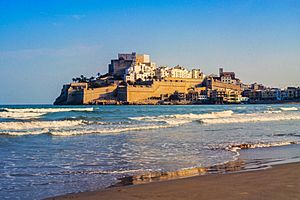Peniscola facts for kids
Quick facts for kids
Peniscola
Peñíscola
|
|||
|---|---|---|---|
| Peñíscola/Peníscola | |||

Peniscola from the beach
|
|||
|
|||
| Country | |||
| Autonomous community | Valencian Community | ||
| Province | Castellón | ||
| Comarca | Baix Maestrat | ||
| Area | |||
| • Total | 79 km2 (31 sq mi) | ||
| Elevation | 46 m (151 ft) | ||
| Population
(2018)
|
|||
| • Total | 7,447 | ||
| Demonym(s) | Peñíscolano, peñíscolana Peniscolà, peniscolana | ||
| Time zone | UTC+1 (CET) | ||
| • Summer (DST) | UTC+2 (CEST) | ||
| Official language(s) | Spanish, Valencian | ||
Peñíscola (also called Peníscola) is a beautiful town in Spain. It is located in the Province of Castellón, which is part of the Valencian Community. This town sits right on the Mediterranean coast, a popular area known as the Costa del Azahar. Peñíscola is a favorite spot for tourists from all over the world.
Contents
Discovering Peñíscola's Past
Peñíscola is often called the "Gibraltar of Valencia" because of its strong, fortified look. Locals also call it "The City in the Sea." This town is built on a rocky hill, about 67 meters (220 feet) high. It connects to the mainland by a thin strip of land called a tombolo. The name Peníscola comes from the Latin word for "peninsula."
Ancient Beginnings
The history of Peñíscola goes back a very long time. The first people to live here were the Iberians. Later, it became a Phoenician town named Tyreche. Then, the Greeks took over and called it Chersonesos, which means "peninsula."
Carthaginian and Roman Times
Next, the Carthaginians captured the town. Their leader was Hamilcar Barca. There's a famous story that says this is where Hamilcar made his son, Hannibal, promise he would always be an enemy of Rome.
The Medieval Castle and Popes
The impressive castle you see today was built by the Knights Templar between 1294 and 1307. In the 1300s, the Knights of Montesa protected it. In 1420, the castle became part of the Crown of Aragon. From 1415 to 1423, the castle was home to Benedict XIII, also known as Pedro de Luna. He was a pope during a time when there were two popes at once. The castle is still sometimes called Castell del Papa Luna (Pope Luna's Castle) in his honor. There's also a cool cave nearby called Bufador del Papa Luna, where seawater sprays out.
Exploring Peñíscola Castle
The castle is a major attraction in Peñíscola. It was first built by the Knights Templar in 1307. Later, in 1319, the Order of Montesa took control. They then gave the castle to the Pope. As mentioned, Antipope Benedict XIII lived here from 1417 until he passed away in 1423.
Castle Restoration and Film History
In 1960, the castle was restored. New walls were even added for the movie El Cid, which was partly filmed here. In the movie, Peñíscola and its castle pretended to be the city of Valencia. Today, the castle is a very popular place for tourists to visit. The beaches and surrounding areas are also great for family holidays.
Enjoying Peñíscola's Festivals
Peñíscola is not just about history; it's also a place for fun events!
Music Festivals
Every summer, Peñíscola hosts two exciting music festivals:
- The International Festival of Ancient and Baroque Music, which started in 1996.
- The International Jazz Festival of Peñíscola, which began in 2004.
At the start of August, a special show with fireworks and music kicks off the Ancient and Baroque Music Festival.
Film Festival Fun
Peñíscola also used to have an annual comedy film festival. This festival brought together Spanish and international actors and filmmakers. Movies were shown in historic places around the town. It made sense for the festival to celebrate comedy, as the city was the setting for a famous funny movie called Calabuch, directed by Luis García Berlanga.
See also
 In Spanish: Peñíscola para niños
In Spanish: Peñíscola para niños





